Ndyuka artifacts are on permanent display at MPM.
There is also a reconstructed façade of a house and two black and white photographs of daily life; a stool; peanut grinding board; combs; food stirrers; and calabash spoons. The exhibit case, called "Bush Negro of Suriname South America" is located on the third floor of the Museum, at the end of the African Hall and the beginning of the South American Hall.
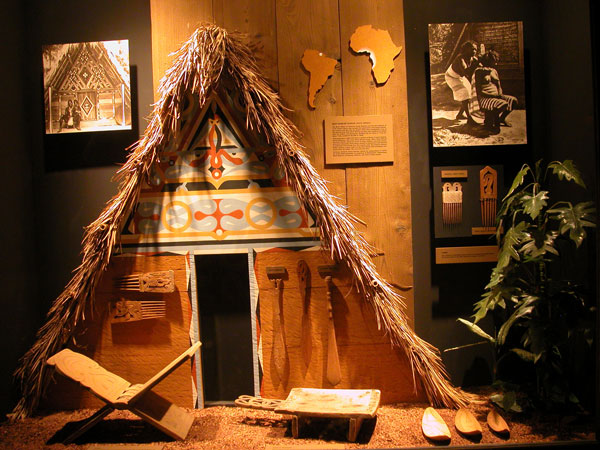
The MPM Suriname exhibit located on the third floor.
Photo taken by Arianna Murphy
Woodcarving
Woodcarving is the most prevalent and intricate art form in Ndyuka society. The tropical forests of Suriname provide a variety of wood types that are suitable for carving, most commonly tropical cedar. The wood carver uses an axe and a machete (and nowadays a chain saw) to cut down trees and gather wood for his work and a small knife for carving his designs. The carver uses a nail and a piece of string and chalk to create his designs on the wood. To give the wood a polished surface, the carver uses sand as an abrasive. Palm oil and smoking will give the wood a darker color. Woodcarvings are often decorated to emphasize a specific design, either with brass tacks or with circular burn marks, made by pressing the heated end of an empty gun cartridge or umbrella tine to the wooden surface. Generally, the designs used in woodcarving are of a curvilinear, geometric nature, such as figure eights, S’s, U’s, scrolls, and curves.
Utilitarian Objects as Love Tokens
Woodcarving is the art form which the Ndyuka are most widely recognized, and the art through which Ndyuka men express love and affection. Between Ndyuka men and women, the giving of gifts is essential for the maintenance of a relationship. Carved items given as gifts help keep a woman’s affection and partnership. These beautiful wooden objects are made in the forms of several different utilitarian objects, commonly food stirrers, combs, trays, paddles, and clothes beaters. Husbands also build their wives a house, as a manifestation of their provision for her in their marriage.

Food stirrer with personal messages carved onto blade
54727/16163
Stirrers, Paddles, and Clothes Beaters
Food stirrers are used in cooking, to stir rice and other foods prepared for ritual occasions. They are relatively flat. The size of the blade and the handle vary according to geographical location and maker. Ndyuka women usually own several stirrers. Most stirrers serve a functional purpose and are actually used by the recipient in cooking, but some are much more delicate and serve purely aesthetic purposes. MPM has 24 food stirrers in its collection.
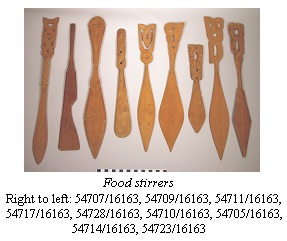
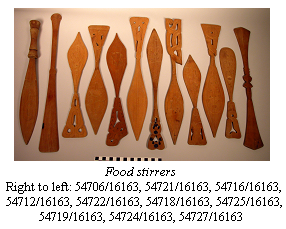
Women’s paddles are smaller than the paddles used by men (due to the different stroke technique, which is much shorter and quicker). The exact size, shape, and decoration vary, like the food stirrers, according to region and artist. Paddles -- unlike food stirrers, clothes beaters, and combs -- are painted with colorful and elaborate designs. MPM has one paddle in its collection.
Clothes beaters are used to beat laundry and hammocks against river rock while washing. The beating end is either a flat, circular shape or a long, narrow shape with relief carving. Like food stirrers, clothes beaters are used frequently in household chores and women often own several of them. MPM has one clothes beater in its collection.
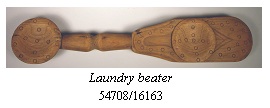
Combs
Combs are one of the most prized handicrafts by Ndyuka women. Not only are they valued for their magnificent craftsmanship, women also use them in styling and ornamenting their hair, an art form in which they take great pride. Because they are used repeatedly, the wooden combs often break after several years’ use, and the woman then receives a new one from her husband. Like food stirrers, some combs are much too delicate to be functional in hair styling, and serve as personal objects that women treasure and display as symbols of wealth. MPM has five combs and one combination comb-food stirrer in its collection.
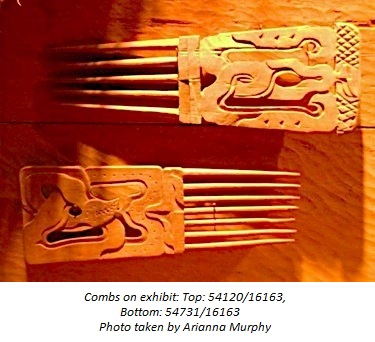
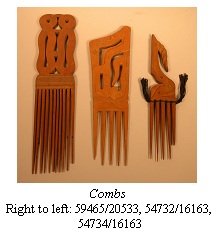
Houses
Ndyuka women’s houses are built for them by their husbands after the marriage ceremony. In this act, he is demonstrating his love and protection over her in their relationship. Men, too, have their own houses that they build for themselves. Men’s homes are much smaller than women’s, because the women live with and raise their children. Ndyuka homes are generally made of wood with thatched roofs, though today galvanized metal imported from the coast is often used for roofing. Traditionally, the width of a house is no larger than the length of an outstretched hammock, which is hung in the rear of the house. A Ndyuka house is divided into two spaces; the back section designated for sleeping, where the hammock is hung; and the larger front space for storage of utilitarian objects, food, medicines, gifts, clothing, and other household items. During the mid-20th century, the facades were boldly and brightly painted with traditional curvilinear and geometric patterns, but contemporary structures are much less ornate; no windows are built into the walls. Most of a woman’s chores, including cooking and laundry, are done outside of her home. Houses are primarily used as storage facilities and places to sleep.
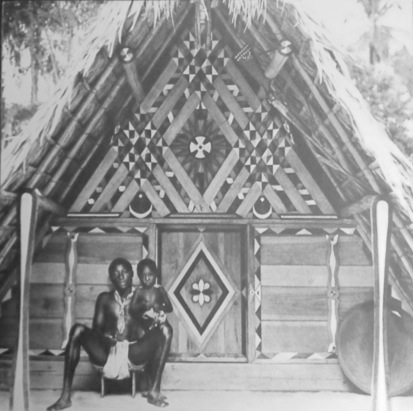
Man and child in front of house.
Photo in MPM exhibit
Calabash Spoons and Dishes
The calabash fruit is native to tropical environments, and its firm exterior provides the Ndyuka with a medium for spoons and dishes. These calabash utensils are decoratively carved, most commonly by women. The designs are curvilinear in nature. The Amerindians of Suriname also used the calabash fruit for containers but Maroon carving techniques and designs are their own invention. Calabash preparation begins when the woman selects the ripe fruits from the tree, saws them in half, and removes the inedible pulp. The resulting shells are immersed in a vat of boiling water over a wood fire and the remaining pulp is scraped out with a spoon at the river’s edge. Next she prepares her carving tool, smashing a bottle to produce sharp pieces of glass, and selecting one to use for incising the lines of her design. The freshly carved bowls are soaked in water, rubbed smooth with an abrasive leaf and then fine sand, dried in the sun, rubbed with lime halves, rinsed, and dried again. They are now ready for use. MPM has five calabash spoons and four calabash dishes in its collection.
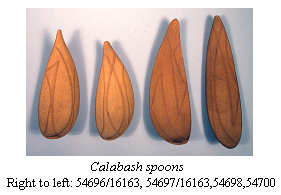
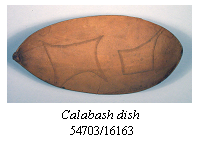
Stools
It is taboo in Ndyuka culture for a person to sit on the ground, so wooden stools are essential and prevalent household items. They are used at home, but are also carried around to council meetings, rituals, canoe trips, and so on. There are five basic types of stools, made either from one piece of wood: composite stools with the seat added, or folding stools made from interlocked pieces. Stools range from very simple with little or no carved design to highly ornate, intricately carved and embellished with brass tacks. The level of complexity or embellishment usually depends on the wealth, status, and woodcarving skill of the individual to whom it belongs. MPM has one folding stool in its collection.

Stool on exhibit: 61463/22289
Photo taken by Arianna Murphy
Peanut Grinding Boards
Most peanut grinding boards are rectangular, made of wood, and have an undecorated top surface on which the peanuts are ground. The ends of the board are often decorated, as well as the legs, which are sometimes included in the design. The designs are usually in low relief and pierced, and are similar to the curvilinear designs found in other Ndyuka woodcarvings. The Ndyuka use peanut paste in a number of dishes, including peanut rice, peanut sauce for meat, and other recipes involving bananas and coconuts. MPM has one peanut grinding board in its collection, which is currently on exhibit.
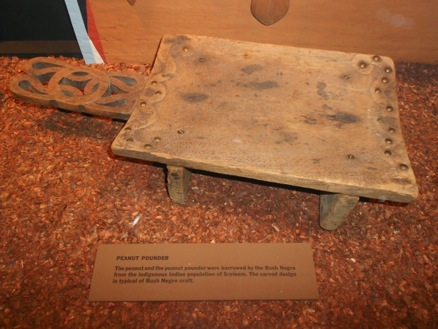
Peanut grinding board on exhibit: 61464/22289
Photo taken by Arianna Murphy
Trays
Almost all Ndyuka wooden trays are round and made from one piece of wood. They range in size from about 15 to 30 inches in diameter. The level of relief carving and the complexity of the design also vary; some are very simple, and others are very elaborate with brass-tack embellishment. The large, round trays are primarily used for winnowing rice, to separate the grain from the husk. They are also used for carrying and presenting food. Rectangular trays are also made, but are much less common. These trays are used for bringing food to men’s meals. Unfortunately, MPM does not have any trays in its collection.
Canoes
Canoes are integral to the Ndyuka way of life because they serve as the primary mode of transportation. Canoes are made by Ndyuka men and require considerable time and effort to build. All canoes are dugouts, meaning they are carved out of a tree felled by the maker (see preceding "Gender Roles" section). The centers of the logs are hollowed and burnt out, and the shell is gradually opened and widened using heat. Canoe lengths range from about ten to 50 feet and are usually painted with bright colors and bold designs.
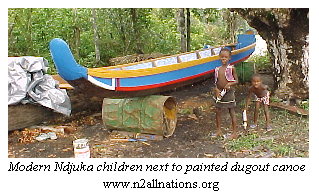
Hammocks
Hammocks, along with stools, are one of the most common household objects in Ndjuka society. In lieu of beds or floor mats, the Ndjuka people sleep in hammocks made from natural fibers, such as cotton (obtained from trade with the South American Indians) or grass, and they are hung in every home. Like many other types of Ndjuka art, the quality and style of hammocks vary. MPM has two hammocks in its collection.

Body Modification and Personal Adornment
Cicatrization
Although the practice has significantly diminished in recent years, cicatrization, or decorative scarring, was once common in Ndyuka society. Almost always done by women, cicatrization designs were seen as an important aspect of beauty and sexuality. For women, the practice is a sort of female bonding experience; women often arrange to have their cicatrizations cut together, and they are always done by a female. Women get their cicatrizations recut every few months, gradually reducing the frequency over the years. Having the skin cut open again and again builds the scar tissue, making the pattern on the skin more prominent. Over the centuries, the stylistic tastes have changed, altering the patterns, locations, and quantity of cicatrizations. In the mid-twentieth century, it was common for women to have cicatrization patterns on their face, chest, abdomen, buttocks, and thighs. Today, especially the younger women and girls, minimal cicatrizations on the abdomen, and maybe the thighs, are typical. Cicatrization was practiced by Ndyuka men until the early 1900s, but since then, the practice has been reserved for women only.
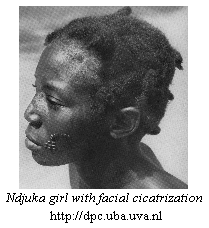
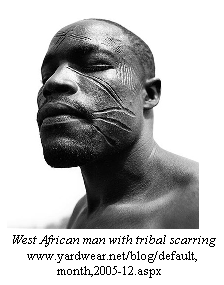
Hairstyles
Ndyuka women take a considerable amount of time in combing and braiding their hair. They normally have their hair braided, often by a female friend or relative, once every few days. The hair is combed, parted, and braided into one or more braiding patterns. Like cicatrization, hair braiding used to be commonly done by men as well as women, but the trend has fluctuated since the 1930s. Also like the tradition of cicatrization, the practice of hair braiding is a West African tradition that was kept alive by the Ndyuka and is still very popular today.
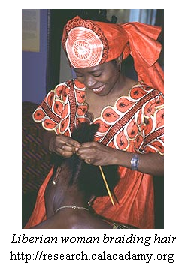
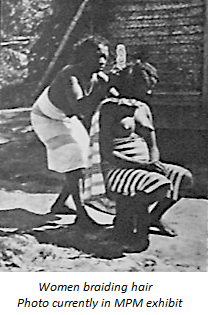
Jewelry
There are a variety of accessories that the Ndyuka employ in personal adornment, including calfbands, anklets, earrings, necklaces and armbands. Calfbands are worn by women and men both to enhance their beauty and to serve as symbols of celebration, and are thus often worn to funerals and other ceremonies. Ndyuka women commonly stack aluminum anklets in order to shape the lower leg into a cylindrical shape. Jewelry is now commercially produced by the Ndyuka, but is also worn by the native populations. Earrings and necklaces are made from a wide range of materials including gold, silver, natural fibers, and shells. Armbands, made of either metal or natural fibers, are worn for protection against witchcraft and sorcery. They often include cowrie shells, small parrot feathers, and leaf mixtures, which are believed to possess these protective powers. MPM has eight pairs of armbands in its collection.
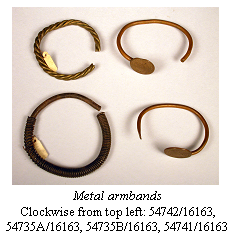
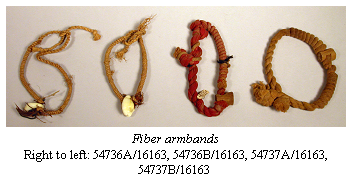
 Clothing
Clothing
Traditionally, and most basically, Ndyuka women wear one or two pieces of cotton cloth wrapped either solely around the waist, or around the waist and one shoulder; this cloth is called a pangi. It was once common for women to go about daily life bare-breasted, but today Ndyuka women often wear bras or sleeveless shirts in addition to the pangi. These pangi are generally brightly colored. Until the past 30 years, men typically wore a breechcloth, tied around the waist, and sometimes a cape tied over one or both shoulders. Like the women’s pangi, men’s capes are brightly colored and sewn in geometric patterns. Nowadays, many men wear breechcloths only for ceremonial occasions and don Western clothes such as jeans and teeshirts for everyday. Ndyuka children are generally naked until around the age of ten. The cotton cloth that the Ndyukas commonly wear has always been imported from the coast rather than locally manufactured. MPM has no pieces of Ndyuka clothing in its collection.
Pemba Dotee
The Ndyuka use a white clay, called pemba dotee, to rub on many of their shrines and religious or ceremonial objects. The pemba dotee is also used to cover the skin of individuals during ritual dances or when communicating with the gods. MPM has a sample of this sacred white clay in its collection.
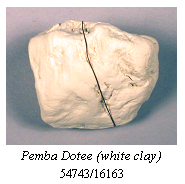
Drums
Drums are a very important aspect to both the Ndyuka artistic and religious traditions. The Ndyuka believe that drums are essential in communicating with the gods and are used in worship along with singing and dancing. Drums, made of wood and animal skin, are carved in low relief and employ the traditional curvilinear designs of Ndyuka woodcarving. MPM has no Ndyuka drums in its collection.

